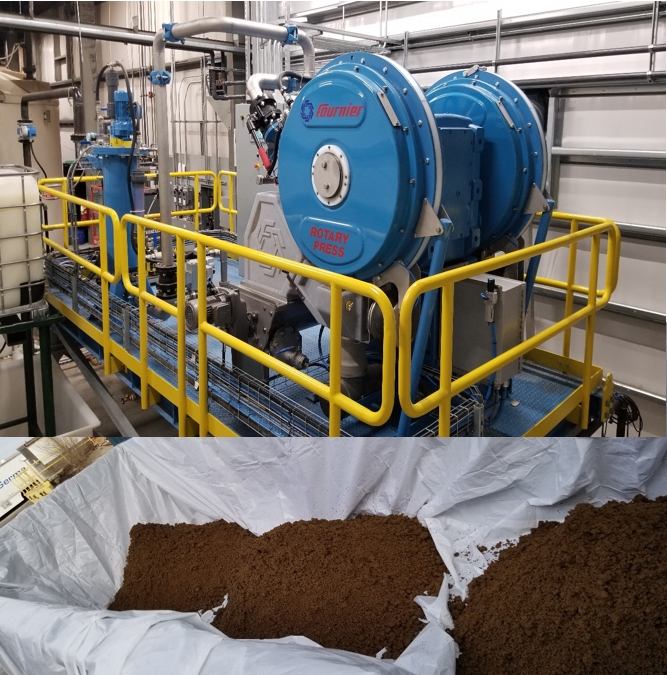
Features
Equipment & Systems
Packaging
Paper
From sludge to solids: Fournier rotary press maximizes dryness
An Ontario containerboard mill is using a Quebec-made rotary press for sludge management
February 24, 2020 By Kristina Urquhart
 Sonoco's Brantford, Ontario containerboard mill received a single two-channel Fournier Rotary Press (top) to achieve sludge dryness of about 20 per cent (bottom).
Sonoco's Brantford, Ontario containerboard mill received a single two-channel Fournier Rotary Press (top) to achieve sludge dryness of about 20 per cent (bottom). A new rotary press installed at an Ontario mill is dewatering paper sludge to improve product cleanliness, and to help cut down on tipping charges during disposal.
Sonoco’s Brantford paper mill received a single two-channel Fournier Rotary Press in October 2019 from Tecumseth, a Toronto-area distributor that services the pulp, paper and wastewater industries.
Fournier’s press technology was developed in Quebec and converts mill sludge to high solids, or “cake,” using relatively little energy – a single press unit uses a five HP (3.7 kW) motor and a six-press unit clocks in at 20 HP (15 kW). Sonoco Brantford’s press includes a 7.5 HP motor.
The rotary press can process primary effluent from dissolved air flotation (DAF), rotary drum thickeners (RDT) and cleaner rejects, as well as more-difficult-to-dewater secondary sludge, whether sourced from aerobic composting, anaerobic digestion or clarifiers. The resulting solids content averages about 30 per cent.
Ken Klempner, president of Tecumseth, says that the Fournier press is a recent addition to the pulp and paper market after initially being developed for dewatering in municipal applications.
With a smaller footprint than a screw press or belt press, the rotary press is completely enclosed to help to keep chemical smells at bay, and an automated five-minute flush cleans the filter plates every day. A sludge pump controlled by a variable frequency drive ensures maintenance of feed pressure, which can be adjusted from two to eight psi.
Constant and consistent pressure allows the press to operate automatically. The system is monitored and controlled by a PLC and can be interfaced with a mill DCS or SCADA system.
The sludge pump feeds into a flocculation unit, which mixes the sludge with a polymer solution fed in at a constant rate. Once the flocculated sludge enters the watering channel at the top of the press, it gets pushed at low pressure between two stainless-steel filter plates rotating continuously at about one RPM.
The sludge thickens as it travels around the channel, draining water as it goes. The friction caused by the sludge moving slowly toward a restricted outlet at the bottom of the press creates enough back-pressure to dewater the solids to a dry cake.
The cake can then be removed for disposal, helping to minimize hauling costs and decrease tipping charges.
Sonoco’s Brantford mill receives sludge from a secondary treatment operation at about 2.7 per cent solids and thickens it to as much as 20 per cent cake solids. Prior to the rotary press installation, secondary sludge was either directed back into the process or taken away from the mill by tanker truck.
Another Tecumseth client, Alberta Newsprint Company (ANC), recently replaced a belt press and screw press combination with two eight-channel Fournier rotary presses that have turned sludge containing 16 per cent solids into cake with 27 per cent solids.
The paper mill uses its solids for land application, so the sludge has a far way to travel to its final destination, says Kerilynn Hnatuk, assistant environment coordinator at ANC. “The dryer it is, the cheaper it is.”
ANC’s belt press had been installed in 1990, and the screw press was added in 1995 to help process extra fibre from a deinking facility the mill ran at the time. “We shut down our deinking facility in 2004 and then we just didn’t have the fibre to help facilitate really good dewatering,” says Dan Moore, environmental manager at ANC.
“We weren’t doing any better than what the belt presses were doing, and our trucking costs were just going up and up as time went on. We needed new technology. The Fournier equipment is really a game changer in terms of getting people to be able to dewater their sludge better.”
The level of dryness achieved by rotary presses also make them ideal for setting up sludge-to-energy systems, says Klempner. Organic sludge with over 25 per cent dryness can be used in a cogeneration burner to create energy.
“That’s the ultimate thing we’re hoping to do with pulp and paper mills,” he says.
This article was originally published in the Winter 2020 issue of Pulp & Paper Canada.
Print this page